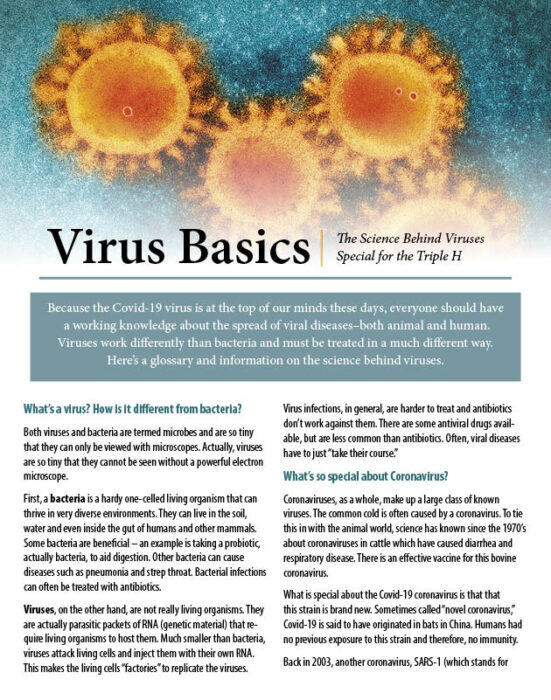Because the Covid-19 virus is at the top of our minds these days, everyone should have a working knowledge about the spread of viral diseases–both animal and human. Viruses work differently than bacteria and must be treated in a much different way. Here’s a glossary and information on the science behind viruses.
What’s a virus? How is it different from bacteria?
Both viruses and bacteria are termed microbes and are so tiny that they can only be viewed with microscopes. Actually, viruses are so tiny that they cannot be seen without a powerful electron microscope.
First, a bacteria is a hardy one-celled living organism that can thrive in very diverse environments. They can live in the soil, water and even inside the gut of humans and other mammals. Some bacteria are beneficial – an example is taking a probiotic, actually bacteria, to aid digestion. Other bacteria can cause diseases such as pneumonia and strep throat. Bacterial infections can often be treated with antibiotics.
Viruses, on the other hand, are not really living organisms. They are actually parasitic packets of RNA (genetic material) that require living organisms to host them. Much smaller than bacteria, viruses attack living cells and inject them with their own RNA. This makes the living cells “factories” to replicate the viruses.
Virus infections, in general, are harder to treat and antibiotics don’t work against them. There are some antiviral drugs available, but are less common than antibiotics. Often, viral diseases have to just “take their course.”
What’s so special about Coronavirus?
Coronaviruses, as a whole, make up a large class of known viruses. The common cold is often caused by a coronavirus. To tie this in with the animal world, science has known since the 1970’s about coronaviruses in cattle which have caused diarrhea and respiratory disease. There is an effective vaccine for this bovine coronavirus.
What is special about the Covid-19 coronavirus is that that this strain is brand new. Sometimes called “novel coronavirus,” Covid-19 is said to have originated in bats in China. Humans had no previous exposure to this strain and therefore, no immunity.
Back in 2003, another coronavirus, SARS-1 (which stands for Severe Acute Respiratory Syndrome) arose in China and affected 26 countries and resulted in more than 8,000 cases. In 2012, MERS (Middle East Respiratory Syndrome) was another coronavirus that was first reported in Saudi Arabia. SARS-CoV-2, the virus that causes COVID-19, is closely related to these known coronaviruses but is more severe.
Viruses are known to mutate quickly into new strains. Think about it this way: A virus needs a “gate” to enter a living cell and each virus strain has a particular protein “spike” that may fit into a receptor of a cell. This is almost like a key fitting in a lock. If the spike fits into the receptor, the gateway is opened to infect the cell. When a person or animal has antibodies, this receptor may already be filled and the virus can’t attack the cell. This is how immunity works.
The Basics of Immunity
There are two types of immunity – active and passive.
Active immunity is the process of exposing the person/animal to an antigen to generate an adaptive immune response. An antigen is a toxin or foreign substance that causes an immune response (like a virus.) The response takes days/weeks to develop but may be long lasting—even lifelong. Active immunity can be acquired by exposure to the antigen or through a vaccine.
Passive immunity refers to the process of providing antibodies to protect against infection; it gives immediate, but short-lived protection—several weeks to 3 or 4 months at most. An example would be a broodmare passing her own antibodies across the placenta to a foal.
Serology, or blood testing, can determine if a person or animal has been exposed to a virus. If the test is positive for antibodies, the person/animal has been exposed or vaccinated, and would be a safe individual to be active in a larger group or herd. The length of immunity, especially in new virus strains, can vary. Testing and accumulating data is the only way to determine how long immunity lasts.
Quarantine and Herd Immunity
As horsemen, most of us understand and have experienced strangles, a highly contagious disease that causes abscesses in the lymph nodes. It takes one affected horse to infect the entire barn of buggy horses on a church Sunday morning! That situation is similiar to what we are experiencing in our human pandemic.
Quarantine, or isolating an affected person or animal, is an effective way of preventing disease spread. As an example, you would isolate a horse that had strangles to prevent infecting your entire stable.
Herd immunity refers to the general population slowly acquiring immunity due to community spread. Exposure of many individuals over time leads to a high percentage of the population with antibodies to a virus. Eventually, infection rates will slow. Again, with strangles, once your entire barn has been exposed, only your unexposed young or new horses may contract the disease.
In the case of Covid-19, our government has chosen quarantine in order to control the spread of the virus. This was done to prevent a huge surge of cases and help hospitals from being overwhelmed. As quarantines are lifted, herd immunity will start to come into play as people slowly become exposed to Covid.
The Process of Developing Vaccines
In developing any sort of vaccine, extensive testing is involved. Fast tracking vaccine development takes about two years. There is much testing that has to be done to make sure it is safe and has no negative effects. Researchers don’t want to fast track a vaccine, but kill animals/people in the process.
There are several Phases to any vaccine study. Before a vaccine can be developed, first the virus must be identified. After that, a vaccine concept has to be created, which will determine how a vaccine will attack a virus. Once this is done, the vaccine is tested in the lab on animals.
Phase I clinical trials are small-scale trials to assess whether the vaccine is safe in humans and what immune response it evokes.
Phase II clinical trials are larger and look mainly to assess the efficacy of the vaccine against artificial infection and clinical disease. Vaccine safety, side-effects and the immune response are also studied.
Vaccines that progress to Phase III clinical trials are studied on a large scale of many hundreds of subjects across several sites to evaluate how effective they are under natural disease conditions. If the vaccine retains safety and efficacy over a defined period, the manufacturer is able to apply to the Food and Drug Administration for a license to market the product for human use.
Phase IV examines several issues that must be studied over time. It answers questions such as how long does immunity last for the vaccine and how well did it perform.
There’s always the chance that when researchers find a vaccine, they may find that the virus has mutated. Influenza vaccines work this way – if a new strain is more prevalent, the “flu shot” isn’t as effective in preventing the disease.
Covid-19 and other Animals
Can Covid-positive people infect our animals? To date, a few pet dogs and cats and a tiger have tested positive for Covid. In the case of the tiger, a Covid positive zoo employee is thought to be the source of infection. Based on the limited information available to date, the CDC (Centers for Disease Control) says the risk of animals spreading Covid-19 to people is low.
However, in some situations, they believe the Covid virus can can spread from people to animals. Scientists are still learning about how this new virus works.
Horses have been known to have been infected with other strains of coronaviruses, but, again, not enough is known about Covid to come to any conclusions. There are no reported cases at this time.
Will there be issues importing horses from Europe? According to experts, the problems will mostly likely lie with limited staff, rather than any danger from horses. The typical 30 day quarantine period will probably not change.
Could horses play a part in a Covid treatment?
Not long ago, research was done at the CDC on treating (human) botulism with plasma transfusions. Plasma is the liquid part of blood that contains antibodies and proteins called immunoglobulins. When a recovered animal or person is affected, these factors can be transfused into a sick individual to help fight the disease.
The use of blood plasma treatments is not new science, but it is effective. However, since it is one patient donating to another patient, it’s a limited treatment.
In the case of the botulism study, horses were hyper-immunized and then the antibody-rich plasma was harvested. Because horses produce so much more volume, their plasma could treat many people at a time. Experts have said that draft horses were used in this study.
It’s exciting to think that the same technology could be used to produce a high volume of plasma treatments for Covid-19 cases However, this will need to be studied extensively before it is ever used. As with all virus research, it takes time and patience. ~
– Special for the Triple H by Beth Miller, Sugar Bush Design

